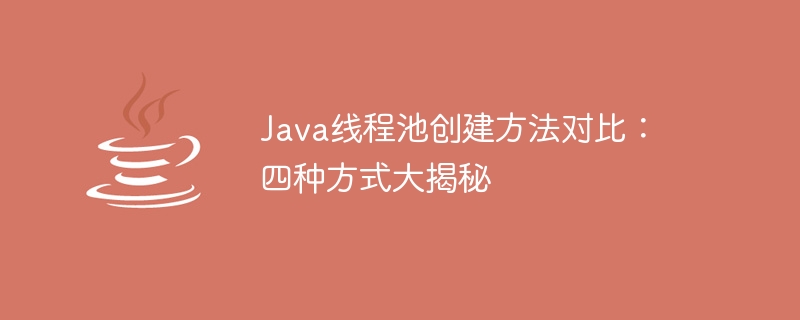

Comparison of Java Thread Pool Creation Methods: Four Methods Revealed
In Java multi-threaded programming, thread pools are a commonly used technology that can control concurrency. The number of threads improves system performance and stability. Java provides a variety of methods for creating thread pools. This article will compare four commonly used creation methods in detail and provide specific code examples.
ThreadPoolExecutor is the most basic thread pool implementation class provided by Java. A thread pool can be created by calling its constructor method. Using ThreadPoolExecutor to create a thread pool requires manually specifying parameters such as the number of core threads, the maximum number of threads, and thread idle time, which is highly flexible.
Specific code example:
ExecutorService executor = new ThreadPoolExecutor(
corePoolSize, //核心线程数
maximumPoolSize, //最大线程数
keepAliveTime, //线程空闲时间
TimeUnit.MILLISECONDS, //时间单位
new LinkedBlockingQueue<Runnable>(queueSize)); //任务队列Java provides an Executors tool class, which can be quickly Create different types of thread pools, such as FixedThreadPool, CachedThreadPool, ScheduledThreadPool, etc. Compared with customizing ThreadPoolExecutor, this method can save the process of manually configuring parameters.
Specific code examples:
ExecutorService executor = Executors.newFixedThreadPool(nThreads);
RejectedExecutionHandler is an interface in ThreadPoolExecutor, which is used to handle problems that the thread pool cannot handle. Task. By customizing RejectedExecutionHandler, you can flexibly configure the rejection policy for task execution when creating a thread pool.
Specific code example:
RejectedExecutionHandler handler = new RejectedExecutionHandler() {
@Override
public void rejectedExecution(Runnable r, ThreadPoolExecutor executor) {
// 自定义拒绝策略
}
};
ExecutorService executor = new ThreadPoolExecutor(
corePoolSize,
maximumPoolSize,
keepAliveTime,
TimeUnit.MILLISECONDS,
new LinkedBlockingQueue<Runnable>(queueSize),
handler);ForkJoinPool is a new thread pool implementation in JavaSE7, mainly used to perform divide and conquer Task. Compared with ThreadPoolExecutor, ForkJoinPool can split tasks into smaller subtasks and hand them over to different threads for execution, improving task parallelism.
Specific code examples:
ForkJoinPool executor = new ForkJoinPool();
To sum up, this article introduces four commonly used thread pool creation methods. From the aspects of flexibility, convenience, rejection strategy, and task splitting, developers can choose the appropriate way to create a thread pool based on actual needs. In actual development, rational use of thread pools can improve system performance, stability, and scalability.
(Note: The above code is only an example, please make appropriate modifications and configurations according to specific needs when using it)
The above is the detailed content of Revealing the Four Creation Methods of Java Thread Pool. For more information, please follow other related articles on the PHP Chinese website!
 java multithreaded programming
java multithreaded programming
 Advantages of downloading the official website of Yiou Exchange App
Advantages of downloading the official website of Yiou Exchange App
 Registration-free CDN acceleration service
Registration-free CDN acceleration service
 What are the problems with using php
What are the problems with using php
 What are the e-commerce platforms?
What are the e-commerce platforms?
 Python return value return usage
Python return value return usage
 JavaScript escape characters
JavaScript escape characters
 How to solve the problem of failure to load dll
How to solve the problem of failure to load dll
 Complement algorithm for negative numbers
Complement algorithm for negative numbers




